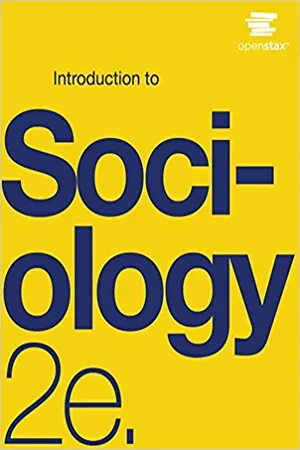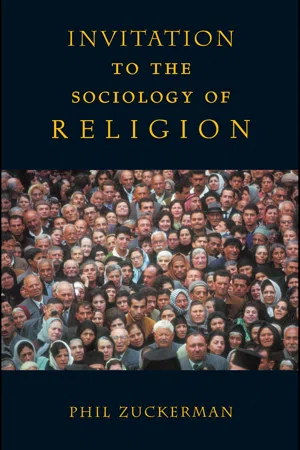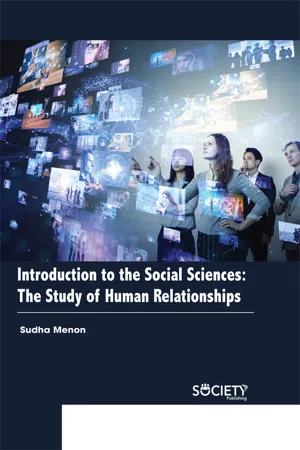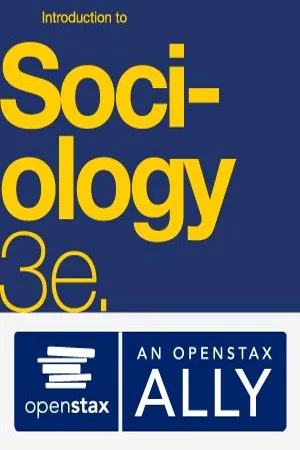Social Sciences
What is the Study of Sociology?
Sociology is the study of society, social interactions, and social institutions. It examines how individuals and groups interact within a society, and how social structures and systems influence human behavior. Sociologists use various research methods to understand and analyze social phenomena, with the goal of gaining insights into social patterns and dynamics.
Written by Perlego with AI-assistance
Related key terms
1 of 5
11 Key excerpts on "What is the Study of Sociology?"
- eBook - PDF
Foundations of Sociology
Towards a Better Understanding of the Human World
- Richard Jenkins(Author)
- 2018(Publication Date)
- Red Globe Press(Publisher)
15 Two What is Sociology? There are many views about what sociology is and what its business should be, all of them bound up with questions about the nature of its subject matter. Apart from the vague ‘study of society’ that’s probably the most common fall-back position, sociology can be defined in a number of complementary ways. At its most basic it is the study of patterns in human behaviour. Among other things this means that sociology pays particular attention to established relationships between humans, which is why the study of institutions and how they work has always been fundamental to the sociological enterprise. Sociology has, however, always been as interested in individuals as in collectiv-ities. It is particularly concerned with the many ways in which individuals are influenced by human factors outside their immediate environment or control. Finally, sociology has always been concerned with the shared ways in which human beings interpret their lives, with meaning. What connects all of these is that sociology is the study of the recurrent or regular aspects of human behaviour. Wishing one neighbour a good morning and ignoring another is not, as a one-off occurrence, sociologically interesting. Do it every day, and, as an established relationship of inclusion and exclusion, it becomes so. If this can be connected to wider patterns of behaviour – for example, if the neighbour that you ignore is a member of a different ethnic group than both you and the neighbour that you greet – its sociological interest increases. Similarly, the fact that one woman is elected to an otherwise all-male legislature isn’t necessarily sociologically significant. However, that women members come, over time, to number in their tens, scores or hundreds, certainly is. 16 Foundations of Sociology However we define sociology’s subject matter there will be many different perspectives on it. - eBook - ePub
- William Egelman(Author)
- 2012(Publication Date)
- Research & Education Association(Publisher)
CHAPTER 2 Sociology Review CHAPTER 2 SOCIOLOGY REVIEW The following sociology review covers all the major topics found in an introductory level sociology course. The review is broken down as follows: 1: Introduction to Sociology 2: The Methods of Research 3: Socialization 4: Culture 5: Society 6: Social Interaction 7: Groups and Organizations 8: Deviance 9: Family and Society 10: Economics and Society 11: Politics and Society 12: Religion and Society 13: Social Stratification By thoroughly studying this course review, you will be well-prepared for the material on the CLEP Introductory Sociology exam. 1. INTRODUCTION TO SOCIOLOGY DEFINING SOCIOLOGYSociology is the science or discipline that studies societies, social groups, and the relationships between people. The field encompasses both the formation and transformation of particular societies and social groups, including their continuation, dissolution, and demise, as well as the origins, structure, and functioning of social groups.THE UNIT OF STUDYSociologists focus on a number of different levels of analysis in understanding social life. While some study the social interaction that occurs within groups (the social processes represented by behavior directed toward, affected by, or inspired by others in the group), other sociologists study the social structure of group life. Some are interested in the structure of societies. That is, the organization of populations living in the same area who participate in the same institutions and who share a common culture. Others in the field are concerned with the social system, a social group, or with society conceived as a whole unit distinct from the individuals that make it up.Others concern themselves with social relationships, or relationships between people that are based upon common meaning, or with social action, defined as meaningful behavior that is oriented toward and influenced by others. But no matter what is designated to be the unit of study, the focus of the discipline is on social groups and society as a whole, rather than on the individual, which is the focus of psychology. - eBook - PDF
Sociology
Made Simple
- Jane L. Thompson(Author)
- 2013(Publication Date)
- Made Simple(Publisher)
Sociology and the Social Sciences Sociology is about social behaviour, why people behave as they do, what factors in society affect their behaviour, how groups of people in society organise themselves and come tg be as they are. Of course, an interest in 'people' could be claimed by almost every academic dis-cipUne in one way or another. Even nuclear scientists cannot fail to take account of the behaviour and expectations of the people in the society in which they work. But sociology is about more than an 'awareness o f or 'an interest' in people. It is an attempt to study, in as scientific and systematic a way as possible, how societies operate. This means trying to 'stand back' from society a little—watching, re-cording, measuring, evaluating and interpreting what is going on, and 1 2 Sociology trying to explain how and why so many of the things we all take for granted about society come to be as they are. Of course, societies are made up of countless individuals, all differ-ent from each other in many respects. The idiosyncracies of individual behaviour, which in part cause different people to think and react differently, are of interest to sociologists, but are probably more the concern of psychologists. Both disciplines are closely related, but whereas the psychologist tends to start from the individual, the socio-logist usually concentrates on the social group he or she belongs to. Sociologists look more for similarities and patterns that can be detected in the behaviour of numbers of individuals who maybe share the same environment or social class or nationality. They try to make accurate generalisations about the characteristics of human behaviour and social organisation, to identify what causes them and to suggest what their implications might be. It is probably this kind of concern that has in the minds of many laymen earned the sociologist the re-putation of being 'nosey'. - eBook - PDF
- Heather Griffiths, Nathan Keirns, Eric Strayer, Susan Cody-Rydzewski, Gail Scaramuzzo, Tommy Sadler, Sally Vyain, Jeff Bry, Faye Jones(Authors)
- 2015(Publication Date)
- Openstax(Publisher)
Why do we feel and act differently in different types of social situations? Why might people of a single group exhibit different behaviors in the same situation? Why might people acting similarly not feel connected to others exhibiting the same behavior? These are some of the many questions sociologists ask as they study people and societies. 1.1 What Is Sociology? Figure 1.2 Sociologists learn about society as a whole while studying one-to-one and group interactions. (Photo courtesy of Gareth Williams/flickr) What Are Society and Culture? Sociology is the study of groups and group interactions, societies and social interactions, from small and personal groups to very large groups. A group of people who live in a defined geographic area, who interact with one another, and who share a common culture is what sociologists call a society. Sociologists study all aspects and levels of society. Sociologists working from the micro-level study small groups and individual interactions, while those using macro-level analysis look at trends among and between large groups and societies. For example, a micro-level study might look at the accepted rules of conversation in various groups such as among teenagers or business professionals. In contrast, a macro-level analysis might research the ways that language use has changed over time or in social media outlets. The term culture refers to the group’s shared practices, values, and beliefs. Culture encompasses a group’s way of life, from routine, everyday interactions to the most important parts of group members' lives. It includes everything produced by a society, including all of the social rules. Sociologists often study culture using the sociological imagination, which pioneer sociologist C. Wright Mills described as an awareness of the relationship between a person’s behavior and experience and the wider culture that shaped the person’s choices and perceptions. - eBook - ePub
- Phil Zuckerman(Author)
- 2010(Publication Date)
- Routledge(Publisher)
sociology —and then proceed to illustrate how it applies to the second part, religion. Of course, to briefly summarize sociology is no easy task. Every individual sociologist has his or her unique understanding of the discipline, and there will undoubtedly be those who find my attempt to describe sociology lacking. Nevertheless, here I go.Sociologists, in the words of Peter Berger (1963, 18), are “intensively, endlessly, shamelessly” interested in humans. From the behavior of people in elevators to the racing of llamas, from beer drinking to breast implanting, from race relations to rug making—if it involves humans, sociologists are interested. Sociology is distinguished both by its subject matter (what sociologists actually study) and by its particular orientation/perspective (how sociologists look at the world).Here then are my “top ten” components of sociology.1. Sociologists study social groups .
Street gangs and student movements, baseball teams and Boy Scouts, lesbians and libertarians, marines and Mothers Against Drunk Driving, the Ku Klux Klan, the Black Panthers, animal rights activists, taxidermists—in short—any association of people you can think of, a sociologist has been, is, or will be studying it.2. Sociologists study social interaction .
Have you ever been standing with a friend on a street corner, having a great conversation, when suddenly a third person joins you— notice how the dynamic suddenly changes? Have you ever noticed that your boyfriend or girlfriend acts differently when he or she is with you alone than when his or her friends are around? These are just a couple of examples of the kinds of things “micro” sociologists study: how people interact with one another, how people present themselves to one another, how people’s very identities change given various social contexts, circumstances, and forms of interaction (Simmel 1950; Goffman 1959; Garfinkel 1967).3. Sociologists study social institutions and social structures .
Schools. The military. Corporations. Police departments. City hall. The government. Hospitals. Prisons. The family. Courts. Marriage. Industries. The media. Sports. The economy. Political systems. The workplace. The welfare system. And a whole lot more. Sociologists look at the ways certain social structures and institutions frame and shape our lives, greatly affecting where we live, how we live, who we live with—even how long we live. - Sudha Menon(Author)
- 2020(Publication Date)
- Society Publishing(Publisher)
Definition of a Social Science 1 CONTENTS 1.1. Social Science And The Scientific Method ........................................... 2 1.2. Social Science as a Study of Human Beings ........................................ 7 1.3. The Study of Social Relationships ...................................................... 13 1.4. Social Science as a Study of Societies ............................................... 18 1.5. Differences Between Social Sciences And The Humanities ................ 24 Chapter 1 Summary ................................................................................. 28 Chapter Introduction to the Social Sciences: The Study of Human Relationships 2 The initial chapter in this book will try to explore the range of definitions of social sciences, primarily based on their characteristics and differences from other differences. In the first section of this chapter will examine the methodologies that are associated with social science. The second section will highlight how socials sciences help to illuminate our understanding of human beings. In the third section, we consider the relational aspects of social sciences. The fourth section elevates these relations into societal patterns that are of interest to social scientists. The chapter will close by explaining the distinction between traditional social sciences and the humanities, while at the same time acknowledging the links that exist between the two broader fields of study. 1.1. SOCIAL SCIENCE AND THE SCIENTIFIC METH-OD One of the key distinguishing features of social science is the scientific method (Benton and Craib, 2010; Herek, 2018; Trist et al., 2016). Over time, many social scientists have regarded this method as the key to understanding what distinguishes them from other “arts” (Bohman and Nouwen, 1991; Lynd, 2015).- eBook - PDF
Sociology
The Essentials
- Margaret Andersen, Margaret Andersen, Howard Taylor(Authors)
- 2019(Publication Date)
- Cengage Learning EMEA(Publisher)
Due to electronic rights, some third party content may be suppressed from the eBook and/or eChapter(s). Editorial review has deemed that any suppressed content does not materially affect the overall learning experience. Cengage Learning reserves the right to remove additional content at any time if subsequent rights restrictions require it. CHAPTER 5 Social Structure and Social Interaction 105 These same students might put ear buds into their ears as they move on to their next class, possibly tuning in to the latest sounds while tuning out the sounds of the environment around them. Some will return to their residences and perhaps text message friends, download some music, or send a photo via Instagram. Surrounding all of this behavior are social changes that are taking place in society, including changes in technology, in global communication, and in how people now interact with each other. How we make sense of these changes requires an understanding of the connection between society and social interaction. In this way, a sociological perspective can help you see the relationship between individuals and the larger society in which people live. What Is Society? In Chapter 2, we studied culture as one force that holds society together. Culture is the general way of life in any society, including norms, customs, beliefs, and language. Human society is a system of social interaction, typically within geographical boundaries, that includes both culture and social organization. Within a society, members have a common culture, even though there may also be great diversity within it. Members of a society think of themselves as distinct from other societies, maintain ties of social inter- action, and have a high degree of interdependence. The interaction they have, whether based on harmony or conflict, is one element of society. Within society, social interaction is behavior between two or more people that is given meaning by them. - eBook - PDF
- Roland Meighan, Clive Harber(Authors)
- 2007(Publication Date)
- Continuum(Publisher)
For the sociologist the phenomenon is social life and, in adopting a particular stance towards this, he or she makes use of a set of assumptions upon which analysis can be based and which, typically, includes ideas about the following: A Sociology of Educating 1. A view of humankind, i.e. an idea about what distinguishes human beings from other species. 2. A view of society, i.e. a picture of the structural features which emerge, develop, persist and change as a consequence of people acting in association with others. 3. A view of the interrelation between the individual and society. 4. A view of what should be taken as the crucial properties, the fundamental factors, which condition human conduct and experience in a social order. 5. A view of what it is to 'know' or 'understand' the properties of those aspects of social life under investigation. 6. A view of the relationship between 'academic' explanations of social life and the formulation of policies which can be used to direct the everyday affairs of members of society. All these issues can, of course, be interpreted in different ways. However, what is important for our purposes is that the specific interpretation adopted by a working sociologist will influence both what is seen to be problematic about a topic for investigation and the kind of explanation which will emerge from such investigations. PERSPECTIVES IN SOCIOLOGY AND EDUCATIONAL ISSUES It may appear that the preoccupations listed above are unnecessarily complicated and are divorced from the down-to-earth study of either social life in general or education in par-ticular. However, consider the controversy concerning so-called 'compensatory education'. How can we best explain and react to the relative failure of large numbers of working-class pupils in our schools today? Some sociologists, accepting prevailing definitions of school success and failure, have attempted to explain the causes of this occurrence. - eBook - PDF
- Tonja R. Conerly, San Jacinto College, Kathleen Holmes, Northern Essex Community College, Asha Lal Tamang, North Hennepin Community College(Authors)
- 2021(Publication Date)
- Openstax(Publisher)
Results of studies tend to provide people with insights they did not have before—explanations of human behaviors and social practices and access to knowledge of other cultures, rituals and beliefs, or trends and attitudes. In general, sociologists tackle questions about the role of social characteristics in outcomes or results. For example, how do different communities fare in terms of psychological well-being, community cohesiveness, range of vocation, wealth, crime rates, and so on? Are communities functioning smoothly? Sociologists often look between the cracks to discover obstacles to meeting basic human needs. They might also study environmental influences and patterns of behavior that lead to crime, substance abuse, divorce, poverty, unplanned pregnancies, or illness. And, because sociological studies are not all focused on negative behaviors or challenging situations, social researchers might study vacation trends, healthy eating habits, neighborhood organizations, higher education patterns, games, parks, and exercise habits. Sociologists can use the scientific method not only to collect but also to interpret and analyze data. They deliberately apply scientific logic and objectivity. They are interested in—but not attached to—the results. They work outside of their own political or social agendas. This does not mean researchers do not have their own personalities, complete with preferences and opinions. But sociologists deliberately use the scientific method to maintain as much objectivity, focus, and consistency as possible in collecting and analyzing data in research studies. With its systematic approach, the scientific method has proven useful in shaping sociological studies. The scientific method provides a systematic, organized series of steps that help ensure objectivity and consistency in exploring a social problem. They provide the means for accuracy, reliability, and validity. - eBook - PDF
- Bryan S. R. Green, Edward A. Johns(Authors)
- 2013(Publication Date)
- Pergamon(Publisher)
CHAPTER 1 SOCIOLOGY AS A SCIENTIFIC DISCIPLINE ONE of the most puzzling and irritating aspects of sociology to someone first exposed to it is the contrast between the subject matter, which consists largely of aspects of social existence familiar to the layman, and the language used by the sociologist in analysing and describing it; this being largely unfamiliar, esoteric and tech-nical. Part of the difficulty in accepting the necessity of such a language lies in the fact that we are social beings already possessing an everyday language which we use to order our own lives and to make sense of the social world around us. It is hoped that this chapter will show why special words, or the special use of familiar words, is necessary. It is the aspiration of sociology to be a scientific discipline which sets the sociologist apart from the social philosopher, the social critic and the journalistic commentator, even though they may be concerned with the same phenomena. This is not to say that the sociologist claims a monopoly of knowledge or understanding regarding society. He is merely developing one approach to further understanding as intensively as possible. If the results ultimately prove less enlightening than those produced by the philosopher, the commentator or the novelist then at least it can be argued that the effort to apply the methods of scientific ex-planation to social data was necessary and worth while. The most general aim of a science is to establish empirically validated propositions (sometimes called laws) concerning the relationships between events and objects which can be observed directly or indirectly. The scientific approach in social studies may 1 2 AN INTRODUCTION TO SOCIOLOGY at first sight appear desiccated and dull compared to the vivid descriptions possible in historical narrative or to the exciting speculations possible in social philosophy. - eBook - PDF
The New Walford Guide to Reference Resources
Volume 2: The Social Sciences
- R G Lester, Peter Clinch, Heather Dawson, Helen Edwards, Susan Tarrant, R G Lester, Peter Clinch, Heather Dawson, Helen Edwards, Susan Tarrant(Authors)
- 2013(Publication Date)
- Facet Publishing(Publisher)
The first section contains reviews of the contributions to the discipline of key sociologists (such as Marx, Weber, Parsons, Foucault and Hobsbawm). The second section considers the interrelationship between the development of sociology and related fields such as historical geography, cultural studies and subaltern studies. The final part contains 13 essays on key areas of sociological research. These are wide-ranging in scope, including coverage of traditional areas such as class and nationalism as well as more recent areas such as urban sociology and gender studies. 576 The handbook of political sociology: states, civil societies, and globalization T. Janoski [et al.], eds Cambridge University Press, 2005, 838pp. £30. ISBN 9780521526203. A scholarly survey of the field sub-divided into several thematic sections. Key topics include political sociology theory and concepts; the formation, structure and transitions of the state; civil society and the processes of political action; state policy and the impact of globalization upon politics. Each section contains several long essays with extensive bibliographies to guide further reading. Social Structure, Organization & Control class • criminology • social control • social inequality • social mobility • social structure • working-class studies Social Structure Introductions to the subject 577 The inequality reader: contemporary and foundational readings in race, class and gender S. Szelenyi and D.B. Grusky Westview, 2006, 640pp. £27.99. ISBN 9780813343457. A good starting point for students seeking an introduction to examples of contemporary and classic research on social inequality today. It includes coverage of social class, social stratification and racial and sexual inequalities from a range of methodological and theoretical perspectives.
Index pages curate the most relevant extracts from our library of academic textbooks. They’ve been created using an in-house natural language model (NLM), each adding context and meaning to key research topics.










